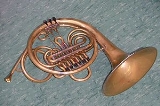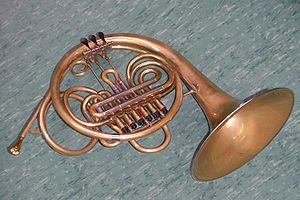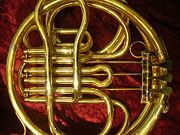
Vienna horn
Encyclopedia
The Vienna horn is a type of musical horn
used primarily in Vienna
, Austria
, for playing orchestra
l or classical music
. It is used throughout Vienna, including the Vienna Philharmonic and Wiener Staatsoper.

 During the nineteenth century, a number of experiments were made in adding valves to the natural horn
During the nineteenth century, a number of experiments were made in adding valves to the natural horn
to enable it to play chromatically without the need for hand-stopping
. These experiments included adding piston valve
s (as used in modern trumpet
s) to a single F horn. The horn was still crooked
, by inserting other tubing, to re-tune the instrument for music written in base keys other than F.
The Vienna horn uses a peculiar form of double-cylinder valve associated with the Viennese firm Uhlmann of the 1840s known as a pumpenvalve. A pumpenvalve is similar to the standard piston valve, but it is not pushed directly inward. Instead, long push-rods reach across to each lever
key (as with rotary valves), allowing either a fast or slow change in the valve, by lever speed. The pumpenvalve allows the air to flow straight when the valves are not actuated. When pressed, each valve redirects the air stream 90 degrees in one bend, lessening the resistance felt by the player. This type of valve is one of the many contributing factors to the incredibly liquid legato
that is one of the trademarks of the Viennese school. However, the indirect linkage between the fingers and the valves via can make the action slow and therefore make quick technical passages more difficult for the player.
The internal diameter of the Vienna horn is also smaller than more modern horns. This bore size and shape is actually very close to the design of the valve-less natural horns. The removable crooks (usually an F and A and/or B) are also smoothly tapered for the length of the horn. Thus, there is no "compromise" (of dual tubing) as found in the modern double horn and triple horn.
Although subsequent developments, including the rotary valve
and double horn, supplanted these horns in most places, the pumpenvalve horn was retained in Vienna because it sounds more like the natural horn: with a more mellow sound and arguably smoother legato. This is due in part to the piston valves and in part to the larger throated (but smaller diameter) bell-flare still used with these instruments. The Vienna horn has remained virtually unchanged since the mid-nineteenth century.
Horn players who use the Vienna horn also use a natural horn mouthpiece, which is convex. A standard horn mouthpiece is concave, partly to facilitate the playing of lower notes.
Horn (instrument)
The horn is a brass instrument consisting of about of tubing wrapped into a coil with a flared bell. A musician who plays the horn is called a horn player ....
used primarily in Vienna
Vienna
Vienna is the capital and largest city of the Republic of Austria and one of the nine states of Austria. Vienna is Austria's primary city, with a population of about 1.723 million , and is by far the largest city in Austria, as well as its cultural, economic, and political centre...
, Austria
Austria
Austria , officially the Republic of Austria , is a landlocked country of roughly 8.4 million people in Central Europe. It is bordered by the Czech Republic and Germany to the north, Slovakia and Hungary to the east, Slovenia and Italy to the south, and Switzerland and Liechtenstein to the...
, for playing orchestra
Orchestra
An orchestra is a sizable instrumental ensemble that contains sections of string, brass, woodwind, and percussion instruments. The term orchestra derives from the Greek ορχήστρα, the name for the area in front of an ancient Greek stage reserved for the Greek chorus...
l or classical music
Classical music
Classical music is the art music produced in, or rooted in, the traditions of Western liturgical and secular music, encompassing a broad period from roughly the 11th century to present times...
. It is used throughout Vienna, including the Vienna Philharmonic and Wiener Staatsoper.
History and description


Natural horn
The natural horn is a musical instrument that is the ancestor of the modern-day horn, and is differentiated by its lack of valves. It consists of a mouthpiece, some long coiled tubing, and a large flared bell. Pitch changes are made through a few different techniques:* Modulating the lip tension as...
to enable it to play chromatically without the need for hand-stopping
Hand-stopping
Hand-stopping is a technique by which a natural horn can be made to produce notes outside of its normal harmonic series. By inserting the hand, cupped, into the bell, the player can reduce the pitch of a note by a semitone or more...
. These experiments included adding piston valve
Piston valve
A piston valve is a device used to control the motion of a fluid along a tube or pipe by means of the linear motion of a piston within a chamber or cylinder.Examples of piston valves are:...
s (as used in modern trumpet
Trumpet
The trumpet is the musical instrument with the highest register in the brass family. Trumpets are among the oldest musical instruments, dating back to at least 1500 BCE. They are played by blowing air through closed lips, producing a "buzzing" sound which starts a standing wave vibration in the air...
s) to a single F horn. The horn was still crooked
Crook (music)
A crook, also sometimes called a shank, is an exchangeable segment of tubing in a natural horn which is used to change the length of the pipe, altering the fundamental pitch and harmonic series which the instrument can sound, and thus the key in which it plays.-Master crook and coupler...
, by inserting other tubing, to re-tune the instrument for music written in base keys other than F.
The Vienna horn uses a peculiar form of double-cylinder valve associated with the Viennese firm Uhlmann of the 1840s known as a pumpenvalve. A pumpenvalve is similar to the standard piston valve, but it is not pushed directly inward. Instead, long push-rods reach across to each lever
Lever
In physics, a lever is a rigid object that is used with an appropriate fulcrum or pivot point to either multiply the mechanical force that can be applied to another object or resistance force , or multiply the distance and speed at which the opposite end of the rigid object travels.This leverage...
key (as with rotary valves), allowing either a fast or slow change in the valve, by lever speed. The pumpenvalve allows the air to flow straight when the valves are not actuated. When pressed, each valve redirects the air stream 90 degrees in one bend, lessening the resistance felt by the player. This type of valve is one of the many contributing factors to the incredibly liquid legato
Legato
In musical notation the Italian word legato indicates that musical notes are played or sung smoothly and connected. That is, in transitioning from note to note, there should be no intervening silence...
that is one of the trademarks of the Viennese school. However, the indirect linkage between the fingers and the valves via can make the action slow and therefore make quick technical passages more difficult for the player.
The internal diameter of the Vienna horn is also smaller than more modern horns. This bore size and shape is actually very close to the design of the valve-less natural horns. The removable crooks (usually an F and A and/or B) are also smoothly tapered for the length of the horn. Thus, there is no "compromise" (of dual tubing) as found in the modern double horn and triple horn.
Although subsequent developments, including the rotary valve
Rotary valve
A rotary valve is a type of valve in which the rotation of a passage or passages in a transverse plug regulates the flow of liquid or gas through the attached pipes. The common stopcock is the simplest form of rotary valve...
and double horn, supplanted these horns in most places, the pumpenvalve horn was retained in Vienna because it sounds more like the natural horn: with a more mellow sound and arguably smoother legato. This is due in part to the piston valves and in part to the larger throated (but smaller diameter) bell-flare still used with these instruments. The Vienna horn has remained virtually unchanged since the mid-nineteenth century.
Horn players who use the Vienna horn also use a natural horn mouthpiece, which is convex. A standard horn mouthpiece is concave, partly to facilitate the playing of lower notes.

